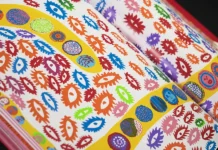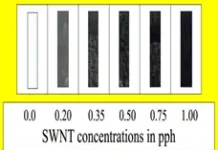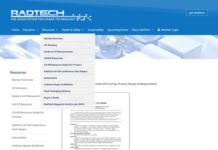By Brian Jasenak, Adam Willsey, James Forish, Kopp Glass
The industrial curing market is rapidly evolving with the introduction of ultraviolet light emitting diodes (UV LEDs). They offer many benefits in certain applications compared to mercury vapor and other similar UV light sources, including lower maintenance costs, greater reliability, low heat, increased power control and, of course, efficiency savings. However, switching costs, formulation compatibility, irradiance uniformity and working distance constraints are challenges for designers of curing systems that still limit their widespread use in UV curing applications. In this article, we discuss the potentially significant benefits of controlled light output in UV LED curing systems that flow from incorporating a customized, precision molded UV transmitting glass optic into the early stages of the system design process. These benefits include the potential for reductions in drive current, improved energy efficiency and thermal management, longer LED useful lives and most importantly, an enhanced and differentiated value proposition for users of these curing systems that will save money and improve quality.
Due to the common practice of using multiple LEDs in an array and the directional nature of their light output, irradiance nonuniformity can occur when the spacing between LEDs in the array causes irregular energy distributions on the incident light surface. Flat windows of fused quartz, fused silica or glass are commonly used to cover and protect multi-UV LED arrays within UV LED curing systems. These covers provide no optical influence and only provide protection.
In this study, a proprietary UV transmitting glass composition and secondary precision molded optic were designed and manufactured to demonstrate their effect on achievable irradiance intensity and uniformity. Prismatic patterning on the light source surface of the optic was used to minimize reflection losses on the incident surface of the glass. Fresnel optics were molded into the opposite side of the UVA transmitting glass to control the refraction of the light and to gain the desired irradiance distribution. The optic was used with two different UV LED arrays.
EXPERIMENT
Irradiance Nonuniformity In UV Led Cure Systems
When using UV LED curing systems, uneven curing can occur when there is a nonuniform irradiance pattern on the cure surface.
Nonuniformity occurs due to the use of multiple single point source LEDs within nonoptimized array designs. The result is an irradiance pattern that has areas with both higher and lower irradiance measurements.
Unlike conventional light sources, which are typically omnidirectional, LEDs emit light in a directional nature. Also, LEDs produce a spectral power distribution with one peak wavelength rather than multiple peaks within a broad spectrum, such as in mercury vapor lamps and other UV emitting light sources.
For UV LED adoption to accelerate in large-format industrial curing and wide-web printing markets, uniformity and irradiance improvements are needed. This study aims to develop a solution to meet those needs.
UV LED array construction and light distribution simulation
 Two LED arrays were designed to simulate two different UV curing systems, pictured in Figure 1A and 1C. One system used four UV LEDs and was designed to produce drastic irradiance nonuniformity. The other system used an additional LED and produced a more uniform light distribution. The arrays were simulated using TracePro to demonstrate the desired light distribution patterns (Figure 1B and 1D).
Two LED arrays were designed to simulate two different UV curing systems, pictured in Figure 1A and 1C. One system used four UV LEDs and was designed to produce drastic irradiance nonuniformity. The other system used an additional LED and produced a more uniform light distribution. The arrays were simulated using TracePro to demonstrate the desired light distribution patterns (Figure 1B and 1D).
UV optic design (patent pending)
 A secondary linear optic (Figure 2) was designed and manufactured to demonstrate its effect on achievable peak irradiance and uniformity. Prismatic patterning on the light source surface of the optic was used to both minimize reflection losses on the incident surface of the glass and to scatter some of the intensity in the high irradiance areas. Fresnel optics were molded into the opposite side of the UV transmitting glass to control the refraction of the light, to re-focus the light onto the target surface and to gain the desired irradiance distribution from the two UV LED arrays.
A secondary linear optic (Figure 2) was designed and manufactured to demonstrate its effect on achievable peak irradiance and uniformity. Prismatic patterning on the light source surface of the optic was used to both minimize reflection losses on the incident surface of the glass and to scatter some of the intensity in the high irradiance areas. Fresnel optics were molded into the opposite side of the UV transmitting glass to control the refraction of the light, to re-focus the light onto the target surface and to gain the desired irradiance distribution from the two UV LED arrays.
Working parameters, components and measurement tools
In this study, the arrays were designed with LED Engin LZ4 UV LEDs with a 395 nm peak wavelength. Measurements were taken in 0.5-inch increments over a 5×8-inch surface area. The LEDs were positioned above the measurement surface at a working distance of 1.5 inches. During the study, a T10 (CL200A) Minolta illuminance meter was used to measure relative irradiance/illuminance on the incident surface. Note: The T10 (CL200A) Minolta meter has a published spectral response at 560 +/-100 nm but is responsive to spectrum of the Engin LZ4 UV LEDs in proportion to irradiance at 395 nm.
UV glass composition: optical and physical properties
 Three proprietary glass compositions were developed that have high transmission across the UV and visible spectrum (Figure 3). For the experiment, the UV-A glass composition highlighted in blue in the plot (page 22) was used for the optic material. Internal transmittance at 365 nm is 92% and is comparable to materials commonly used by industry.
Three proprietary glass compositions were developed that have high transmission across the UV and visible spectrum (Figure 3). For the experiment, the UV-A glass composition highlighted in blue in the plot (page 22) was used for the optic material. Internal transmittance at 365 nm is 92% and is comparable to materials commonly used by industry.
RESULTS AND DISCUSSION
Array Measurements: Irradiance Nonuniformity Improvements
Nonuniform Array with Flat Window Cover
The nonuniform array with a flat window cover produced an irradiance pattern with two high output areas. These areas produced a general relative irradiance of 0.8 to 1.0 (or 80% to 100%) of the irradiance produced by the array. There was a noticeable gap between the irradiance peaks in which the relative irradiance dropped to between 60% and 80%.
Let’s examine the impact of a nonuniform array: Two areas on the same cure surface need the same energy density (Joules/cm). One part of the cure surface is illuminated by an irradiance peak, 100% irradiance, and another part was illuminated by the gap between the irradiance peaks, with 60% irradiance. If the line speed was set such that the area under the 100% irradiance received just enough light energy to cure, then the area that received the 60% irradiance would not be fully cured.
Alternatively, if the line speed is set slowed down so that the area under the 60% irradiance cures completely, then all other areas will be over-cured, which wastes energy and can cause poor cure surfaces in some applications. The result of nonuniform irradiance is wasted energy, slower manufacturing speeds and possibly substandard cure surfaces. To further illustrate the impact to line speeds, it would take 67% more time to cure at 60% irradiance versus 100% irradiance. Uniformity can be greatly improved with a secondary optic made from molded UV glass.
Nonuniform Array with UV Optic
 A linear Fresnel UV optic was designed and used to minimize the nonuniformity seen in Figure 4A. The linear Fresnel UV optic was enhanced with specific diffusion patterns on the back of the optic that minimized reflection losses on the incident surface of the glass.
A linear Fresnel UV optic was designed and used to minimize the nonuniformity seen in Figure 4A. The linear Fresnel UV optic was enhanced with specific diffusion patterns on the back of the optic that minimized reflection losses on the incident surface of the glass.
The resulting relative irradiance pattern is depicted in Figure 4B. Notice the non-uniform irradiance pattern has been nearly eliminated with the addition of an optic; irradiance between LEDs never drops below 95% of the irradiance directly under the LEDs. Additionally, a consistent decline in irradiance is shown when moving away from the irradiance peak.
Curing applications are dynamic in that the cure surface is passed under a light source. To maximize line speed and cure quality, the irradiance between LEDs must be uniform. In figure 4A and 4B, suppose the red line connecting the peak irradiance is perpendicular to the flow of the cure surface. The cure surface passing under 4A will experience large variations in irradiance between the red dots. This will require the line speed to be reduced so that the area between the red dots receives enough irradiance to cure properly. This, of course, means there is wasted irradiation applied to the cure surfaces that pass under the red dots. If 4B is used, the line speed can be increased because the area between the red dots has more irradiation directed to it from the peak areas.
Array Measurements: Irradiance Improvements
An optic can still optimize a UV LED array, even if it is not experiencing drastic irradiance uniformity issues. Most UV LED applications use arrays paired with a flat glass or quartz window covers; a thin (3-6 mm thick) secondary optic can replace this window cover and enhance the overall performance of the system.
 Consider the uniform distribution array depicted in the simulations (Figure 1D). The actual irradiance pattern is depicted in Figure 5A and would be acceptable for most UV curing applications. It has a relatively consistent distribution and increases steadily to the peak of the map.
Consider the uniform distribution array depicted in the simulations (Figure 1D). The actual irradiance pattern is depicted in Figure 5A and would be acceptable for most UV curing applications. It has a relatively consistent distribution and increases steadily to the peak of the map.
The uniform array consisted of five LED Engin LZ4 395nm LEDs, which ran at 700mA. If a traditional flat glass or quartz window covered the array, there would be an opportunity to improve the whole LED system. By replacing the flat window with the linear Fresnel UV optic discussed in the previous example, the irradiance could be increased to a peak value near 120% of the irradiance produced by the array with the flat window cover (Figure 5B).
This irradiance increase allows for two possible improvements to the LED system: The line speed could be increased, or the input current could be decreased. Much like the previous example, increasing the line speed is possible because of the increased irradiance. Less time is required beneath the LEDs because more energy can be focused onto the cure surface.
The use of an optic allows the input current to be decreased, which provides benefits to the actual UV LEDs. An irradiance increase of almost 20% enables numerous benefits to the UV LED system, including reduced power consumption and thermal management requirements, increased working distances and potentially longer LED lifetimes. These benefits and their impact on the UV LED system are discussed in the following section.
CONCLUSION: IMPACT OF THE UV OPTIC
As demonstrated, there are potentially significant benefits of controlled light output in UV LED curing systems that flow from incorporating a customized, molded UV transmitting glass optic into the early stages of the system design process. These benefits are summarized below. UV glass optics have the potential for the system designer to create an enhanced and differentiated value proposition for the users of these systems that will save them money and enhance the quality of the UV LED curing system.
Impact on UV LED Lights
Reduced power consumption and better energy efficiency
The LEDs used in this study’s array have an input power of 700 mA and generate nearly 10W. It can be calculated that by under-driving the UV LEDs in this array by 1W, the same irradiance output could be achieved if a molded UV optic is used.
Higher-performing lights with fewer UV LEDs
When first transitioning to UV LEDs one of the biggest barriers is their high cost. In high-performance flood curing units, it’s essential to maximize irradiance uniformity over large areas, which often requires large numbers of UV LEDs.
A UV optic reduces the initial LED investment required; optics increase irradiance and permit the use of fewer UV LEDs in the unit while still achieving the desired energy density.
Reduced thermal management requirements and extended UV LED useful life
The key to increasing the useful life of a UV LED is proper thermal management. In high-energy applications, UV LEDs require rapid heat extraction; otherwise, increases in junction temperature will lower the luminous flux and cause the UV LED to degrade more quickly.
The use of an optic enables the reduction of the number of UV LEDs required in the array or enables a reduction of the drive current to the UV LEDs. Both of these options produce the desired light intensity while reducing the thermal management requirements.
As mentioned in the above example, the use of an optic could allow the array to be under-driven by at least 1W. A lower current produces less heat to be dissipated. As a result, this increases the effectiveness of the LED system components and can help increase the lifetime of the LED.
Minimized peak wavelength shifts
Excess temperature can cause LED components to break down over time. The metal junctions and the semiconductor material of an LED can deteriorate and, as a result, the luminous flux of an LED will decrease, which can shift the peak wavelength.
The LED Engin LZ4 UV LEDs can approach a 5 nm shift when operated at temperatures near 100°C. By under-driving the LEDs slightly, the strain on the LED components can be reduced. As a result, this decreases the opportunity for wavelength shifting, which can cause issues in the production and quality of UV cured applications.
Impact on UV LED Curing Systems
Improve productivity and cure quality
LEDs can increase the productivity of UV curing operations. They aren’t as variable as mercury vapor lamps, have greater reliability and lifetime, and require less maintenance.
An increase in irradiance can boost the performance of the entire curing operation even more. With higher energy density at the surface, line speeds can be increased and processing times shortened. UV optics improve irradiance uniformity and ensure that even at faster speeds, the system can still produce a uniform cure.
Increase working distances and curing of 3D forms
Molded UV glass optics increase the energy density at the cure surface and enable greater flexibility in cure system working distances. Maximizing irradiance with optics allows the curing of complex 3D surfaces and ensures light is evenly distributed onto the surface.
Brian Jasenak is an optical and process engineer at Kopp Glass. His work focuses on optical lens design, glass and light source selection, and lens fixture design. His background in mechanical engineering gives him a unique perspective for optical engineering.
Adam Willsey is the Kopp Glass manager of research and engineering. He works closely with engineers and the production team to develop new glass compositions to meet customer requirements for color and transmittance.
James Forish, director of product design services, has been with Kopp Glass since 1996. He collaborates with customers and provides design recommendations to decrease manufacturing costs and improve performance.
For more information, visit www.koppglass.com.






